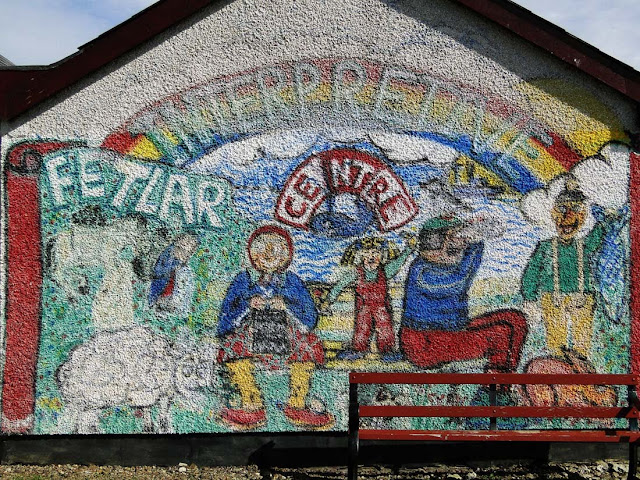Over on Fetlar again today in the sunshine. After completing alloted tasks here are a few pics around the isle.
South end of Fetlar - looking north from the Haa of Funzie.
Funzie Bay, looking south over the Funzie Conglomerate.
Funzie Conglomerate.
The Beach at Funzie Bay.
The Loch of Funzie is one of the best places to see Red-necked Phalaropes on Fetlar. The Loch is adjacent to the road and on calm, sunny days is covered in flies - just what the Phalaropes eat. Its a little late in the year to find them at this time but there was always a chance of one on the loch - but there were none. Apparently they havent been seen much on the loch this year.
The Loch of Funzie. Large areas of Fetlar are RSPB reserves for the breeding Red-necked Phalaropes, along with a few species of waders. 

This display of Fetlar rocks is at the north end of the Loch of Funzie, along with its interpretive board.
Looking north from Funzie.
The Fetlar Camping Böd is at Aithbank.
The view north west from the Camping Böd looking over the Wick of Aith towards Aiths Ness with Lamb Hoga in the distance
A little further north along the isle is a Convent of Anglican nuns - The Society of Our Lady of the Isles (SOLI). The only religious community founded in Scotland during the 20th Century, SOLI began in 1982 when Sister Mary Agnes, a Franciscan nun from England, moved to Shetland and lived as a solitary for five years. In 1988 she founded the Society, which now has four members. In recent years SOLI has flourished and has run a successful retreat programme, the nuns have also expanded their convent and built a larger chapel.

Slightly further north is the Fetlar Community Centre.
This standing stone - the 'Stone of the Ripples' is just above the Leagarth Gardens and overlooks the Wick of Houbie.
Leagarth House is currently undergoing significant renovation. Built in 1900 by Sir William Watson Cheyne - a Fetlar man who achieved fame when he became Lord Lister's assistant in his pioneering work on antiseptic surgery in the late 19th century. He was also a prominent surgeon in his own right.
The Wick of Houbie from the beach.
The Fetlar interpretive centre is just across the road from the Wick of Houbie beach.
Directly across the road from the Wick of Houbie, looking NE along the Feall Burn.
A little further north towards Tresta is the Fetlar campsite.
Tresta beach - an excellent sandy beach.
Towards the north of the island is Brough Lodge, built around 1820 for the Nicolson family. Alongside it is is a Georgian Tower, built for Sir Arthur Nicolson, which was once used as an astronomical observatory.












































.jpg)



Thank You. Enjoyed the photo's.
ReplyDelete